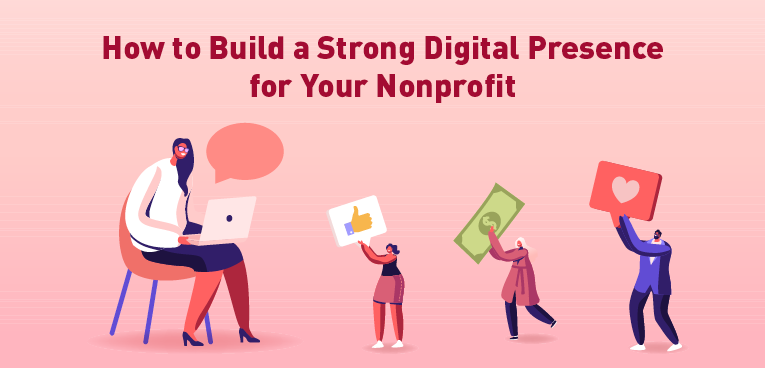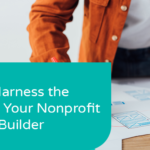How to Build a Strong Digital Presence for Your Nonprofit

Your nonprofit only has a few moments to make a lasting impression on site visitors. In fact, it’s estimated that users will form an opinion about your website in just .05 seconds! Given that your organization needs to grab people’s attention quickly, it’s essential that you build an engaging website that will encourage users to stick around and explore your content.
A well-designed website will give your organization the momentum it needs to expand its reach, drive donations, and deepen connections with supporters. However, if your nonprofit is new to web design, creating a strong digital presence can feel overwhelming. To create a site that accurately represents your organization and stirs up passion for your cause, you’ll need to develop a web design strategy.
As you launch your nonprofit’s website, these tips will help you get started:
- Incorporate your organization’s branding.
- Add accessibility features.
- Create a well-designed donation page.
Your website should effectively introduce new users to your organization and keep existing supporters engaged with your cause. Use these essential tips to turn your site into an asset that actively boosts your donor acquisition and retention, helping you create a thriving supporter base.
Incorporate your organization’s branding.
Your nonprofit needs a way to stand out from the digital crowd. A surefire way to distinguish your organization from other nonprofit organizations online is by clearly branding your website. Nonprofit branding can help your organization:
- Boost visibility
- Strengthen relationships with supporters
- Increase your nonprofit’s credibility
To maintain consistent branding across your website, build a digital style guide with your unique elements that you’ll use to communicate your brand. You can then reference this guide whenever you create new content. According to Loop’s list of nonprofit website best practices, you should include the following brand elements in your style guide:
- Colour palette. Choose a few colours that work well together and speak to your organization’s values. For example, blue conveys feelings like trust and authority in audiences, while red is often associated with passion. If you’re an environmental organization, you could create a colour palette with blue and green to speak to your commitment to the environment.
- Typography. Decide the fonts, use of capitalization, and hierarchy of text headings you’ll use throughout your website. Select fonts that are easy to read so users can engage with your content without getting distracted. For example, many nonprofits use sans-serif fonts for their clarity and legibility.
- Mission and positioning. What sets your nonprofit apart from other organizations championing the same cause? Your website is your opportunity to prove to users why they should support your organization, so leverage your nonprofit’s positioning to highlight your mission, the work you’ve done to date, and goals for the future.
- Tone. Maintain the same tone of voice throughout your content to create a consistent voice. This will facilitate users’ reading experience and create a feeling of continuity so all of your web pages feel like they belong to your nonprofit.
- Logo. Your nonprofit logo should be simple, memorable, and representative of your organization’s values. Display your logo in the top middle or left hand corner of each webpage to boost brand visibility.
You can also extend these elements to your email newsletters, social media graphics, and other marketing materials to create a unified brand across your in-print and digital presence. If you modify any of these branding elements, make sure to reflect this change in your style guide so all members of your team know how to express your updated brand.
Add accessibility features.
The best nonprofit websites make their content accessible to people of all abilities. By prioritizing accessibility in your design, you’ll open your nonprofit up to wider audiences, expanding your support base. Plus, a user-friendly design makes it more likely that supporters will spend more time exploring your website’s resources and even donate to your cause.
Incorporate these accessibility features into your web design to promote inclusivity:
- Alt text. Include a brief description that summarizes your images and how they relate to the rest of your content. This allows people with visual impairments to still engage with your visual elements and build an emotional connection with your organization, especially if your images highlight constituents and your nonprofit’s work in the community.
- Colour contrast. Maintain a colour contrast ratio of at least 4:5:1 to facilitate a positive reading experience. Your text should stand out boldly on each page so your content is legible and easily accessible by all users.
- Closed captions. If your website has video content, provide closed captions that are in sync with the audio content. Closed captions make it easy for people with hearing disabilities to access your content.
- Sequential HTML heading tags. Your heading tags should occur in a hierarchical order, so ensure your title uses an H1 tag, subheaders use H2 tags, and so on.
To make your website more accessible, explore the Web Content Accessibility Guidelines (WCAG) for a complete list of standards to follow. Following these guidelines will not only boost your accessibility, but will also help your website rank higher on search engines.
Create a well-designed donation page.
Your donation page is the foundation of your online fundraising strategy. An informative and user-friendly donation page is much more likely to inspire donations and encourage people to give again in the future. As a result, you can establish a reliable donation pipeline to fund your nonprofit’s events, programs, and invaluable services year-round.
Make sure your donation page has the following elements to ensure a positive user experience:
- Flexible payment options. Offer donors multiple payment options beyond credit and debit card, including Venmo, PayPal, and Zelle. This allows donors to choose their preferred way to give, making the donation process more convenient.
- PCI-compliant payment processor. Choose a donation tool that includes a secure payment processor so your donors’ private information is protected and your nonprofit can safely receive donated funds. This will also help donors build trust in your organization.
- Monthly giving option. Add a monthly giving option to your donation page to encourage recurring giving. Recurring giving is especially useful for frequent donors, since they’ll only have to fill out their billing information and donation amount one time. Then, this amount will automatically be transferred to your nonprofit’s bank account each month, saving your donors time and boosting your nonprofit’s revenue.
You’ll also want to ensure that your donation page, and the rest of your website, is optimized for mobile use. Mobile-friendly websites make it easy for users to engage with your content and give to your organization via their smartphones. In fact, 360MatchPro found that mobile-friendly donation pages yield 34% more donations, making it well worth your time to optimize your site for mobile users.
Use free tools, like Google Lighthouse, to audit your website performance for mobile and find areas of improvement. For example, you can check for elements like page load speed, image quality, and accessibility to improve your mobile users’ experience.
A comprehensive, well-designed website can help take your nonprofit’s mission to the next level. With these tips, your nonprofit can effectively attract new donors and keep existing donors actively engaged in your cause. If you’re new to the web design process, partner with a reputable creative design agency to build a strong digital presence. Good luck!


